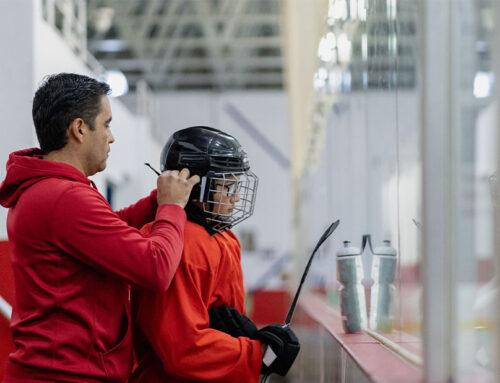The Keys to Improving Pitching Speed and Power
Pitching speed is a product of physics. The more force you can put on the ball, the faster your pitch will be. Most pitchers focus on developing core and shoulder strength to increase their velocity. However, these muscle groups just transfer force to the ball; they don’t create it. That is why if you want to add power to your pitches, you need to build lower-body strength.
Pitching Velocity and Physics
Time for a short physics lesson. Push a door and it will easily swing on its hinges. Pushing a pickup truck isn’t quite so easy. This is because of inertia—an object’s resistance to change in motion or rest. Inertia causes your body to experience any force that you put on an object (that is, unless you break it). The heavier the object or the faster it’s moving, the more force you will experience. That’s why your joints feel an impact when they contact the ground during sprints and why your body feels the full blow when you make a tackle.
Inertia plays an important role in increasing your pitching speed. When you push against the mound during the delivery, the mound won’t budge. All that force instead travels up through your foot, transfers through your hips and core to your shoulder, and exits through the ball when it leaves your hand.
Thus, when training to increase your pitching velocity, you should focus primarily on improving your powerful drive off the mound. Shoulder, wrist and core exercises help ensure this power is then efficiently transferred to the ball, while keeping you injury-free.
Building Strength and Power
Power can only be developed on a fundamentally sound base of strength. Squats, Front Squats, Deadlifts, Lunges and Step-Ups are the best lower-body exercises, because they force you to push against the ground—just like when you pitch. Once these exercises are mastered, you can start performing advanced variations—like Rear-Foot-Elevated Split-Squats and Lateral Lunges—that closely mirror driving off the mound.
Select two of the lifts mentioned above, and perform them during your lower-body strength workout. To learn proper form, begin with three sets of eight to 10 reps with lighter weights. Progressively add weight and decrease reps to four to six as you become comfortable with the exercise. Rest for two to three minutes between sets.
Then, to transfer your strength into power, you need to train your muscles to exert force as quickly as possible. Plyometric exercises that involve quick and powerful movements—like Box Jumps, Lateral Box Jump, Broad Jumps and Lateral Broad Jumps—are best for achieving this goal. For an additional pitching-specific challenge, perform single-leg variations of these exercises.
Select two or three plyometric exercises and perform them during your second lower-body or speed workout. For each exercise, begin with two sets of three to five reps (with each leg if performing single-leg variations). Increase by one set every other week until you reach six sets. Rest for one to two minutes between sets to ensure optimal power gains.
Photo: rotoinfo.com
Carl Galloway, CSCS, is the assistant strength and conditioning coach at Orange Lutheran High School (Orange, Calif.) and a certified Olympic lifting performance coach through USA Weightlifting. He previously played minor league baseball in the Philadelphia Phillies organization. Galloway earned his bachelor’s degree in kinesiology from Biola University and his master’s degree in coaching and athletic administration from Concordia University.
RECOMMENDED FOR YOU
MOST POPULAR
The Keys to Improving Pitching Speed and Power
Pitching speed is a product of physics. The more force you can put on the ball, the faster your pitch will be. Most pitchers focus on developing core and shoulder strength to increase their velocity. However, these muscle groups just transfer force to the ball; they don’t create it. That is why if you want to add power to your pitches, you need to build lower-body strength.
Pitching Velocity and Physics
Time for a short physics lesson. Push a door and it will easily swing on its hinges. Pushing a pickup truck isn’t quite so easy. This is because of inertia—an object’s resistance to change in motion or rest. Inertia causes your body to experience any force that you put on an object (that is, unless you break it). The heavier the object or the faster it’s moving, the more force you will experience. That’s why your joints feel an impact when they contact the ground during sprints and why your body feels the full blow when you make a tackle.
Inertia plays an important role in increasing your pitching speed. When you push against the mound during the delivery, the mound won’t budge. All that force instead travels up through your foot, transfers through your hips and core to your shoulder, and exits through the ball when it leaves your hand.
Thus, when training to increase your pitching velocity, you should focus primarily on improving your powerful drive off the mound. Shoulder, wrist and core exercises help ensure this power is then efficiently transferred to the ball, while keeping you injury-free.
Building Strength and Power
Power can only be developed on a fundamentally sound base of strength. Squats, Front Squats, Deadlifts, Lunges and Step-Ups are the best lower-body exercises, because they force you to push against the ground—just like when you pitch. Once these exercises are mastered, you can start performing advanced variations—like Rear-Foot-Elevated Split-Squats and Lateral Lunges—that closely mirror driving off the mound.
Select two of the lifts mentioned above, and perform them during your lower-body strength workout. To learn proper form, begin with three sets of eight to 10 reps with lighter weights. Progressively add weight and decrease reps to four to six as you become comfortable with the exercise. Rest for two to three minutes between sets.
Then, to transfer your strength into power, you need to train your muscles to exert force as quickly as possible. Plyometric exercises that involve quick and powerful movements—like Box Jumps, Lateral Box Jump, Broad Jumps and Lateral Broad Jumps—are best for achieving this goal. For an additional pitching-specific challenge, perform single-leg variations of these exercises.
Select two or three plyometric exercises and perform them during your second lower-body or speed workout. For each exercise, begin with two sets of three to five reps (with each leg if performing single-leg variations). Increase by one set every other week until you reach six sets. Rest for one to two minutes between sets to ensure optimal power gains.
Photo: rotoinfo.com
Carl Galloway, CSCS, is the assistant strength and conditioning coach at Orange Lutheran High School (Orange, Calif.) and a certified Olympic lifting performance coach through USA Weightlifting. He previously played minor league baseball in the Philadelphia Phillies organization. Galloway earned his bachelor’s degree in kinesiology from Biola University and his master’s degree in coaching and athletic administration from Concordia University.











